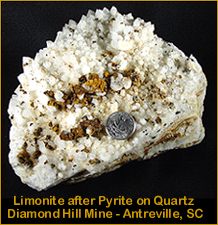The following specimen is one of the oddest that we found. Overlying the dogtooth
quartz is a secondary growth of silica partially covered by black and brown manganese and iron oxides. Also
contained on the specimen are cone-shaped hollow casts of silica. The secondary layer of quartz has
psuedomorphed the outer shape of a mineral that has been dissolved. I don't know what the pre-existing
mineral was - but perhaps it may have been calcite.
Speaking of psuedomorphs - I found another area in the mine that contained a whole
bunch of tiny limonite after pyrite crystals and clusters on quartz. I didn't know that I
had these little buggers until I cleaned all the mud off the rocks.


Click on above image to enlarge
| |
No visit to Diamond Hill would be complete without banging on a few boulders
in an area where the relatively scarce phosphate mineral, cacoxenite, seems to appear. The tiny fibrous
"balls" aren't big, but they are way cool!
Click on each cacoxenite image to enlarge
The shape of a specimen can sometimes trump that it is composed of only common
quartz. When I handed Chrissy the specimen pictured below, she instantly named it the "slipper" and
could hardly wait until I was able clean off the mud and oxides. I have learned that when Chrissy
names a specimen while collecting that I might as well get the newspaper out for her to carefully
wrap it for its ride home.
So much for yet another glimpse into the incredible variety of material to be found at Diamond Hill.
Be sure to check out the Field Trip Reports page on McRocks.com or get a copy of the March 2005
issue of Rock & Gem Magazine for a bunch more Diamond Hill field trip reports.
CLICK THE LITTLE MINER TO RETURN TO THE FIELD TRIP PAGE
